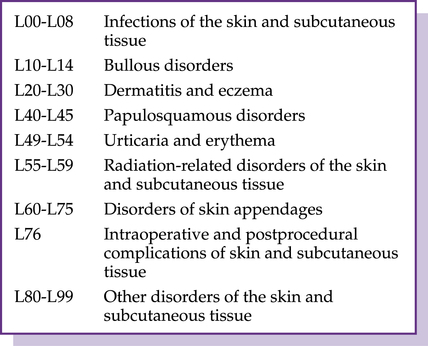CHAPTER 5 After completing this chapter you should be able to 1. Examine the digestive system coding. 2. Review coding the skin and subcutaneous tissue diseases. 3. Understand diseases of the musculoskeletal system and connective tissue coding. Chapter 11, Diseases of the Digestive System, in the Tabular of the I-10 describes diseases or conditions affecting the digestive system. Digestion starts when food is taken into the mouth and follows the gastrointestinal tract until it leaves the body through the anus. The categories in the I-10 are sequenced in a manner that follows that path, starting with disorders of the teeth. The blocks in Chapter 16 are as illustrated in Figure 5–1. Chapter 12, Diseases of the Skin and Subcutaneous Tissue (L00-L99), in the Tabular of the I-10 describes diseases or conditions of the integumentary system. Conditions affecting the nails, sweat glands, hair, and hair follicles are included in this chapter. Congenital conditions of skin, hair, and nails are classified in category Q80-Q89, Other congenital malformations. Neoplasms of skin are classified in Chapter 2 of I-10. The blocks of Chapter 12 include those displayed in Figure 5–2. Pressure ulcers develop when the circulation to an area is decreased by the application of pressure to the area. Patients restricted to bed or unable to change position often develop pressure ulcers. As the sores ulcerate, the deeper layers of tissue, such as fascia, muscle, and bone, may be affected. Pressure ulcers are graded and reported based on the depth of ulcer and categorized in stages as illustrated in Figure 5–3. The stages are: Figure 5–4 illustrates the codes to report pressure ulcer of the left hip that include the stages in the code description. Chapter 13, Diseases of the Musculoskeletal System and Connective Tissue, in the I-10 Tabular describes diseases or conditions of the bone, joints, and muscle, and the blocks are displayed in Figure 5–5.
Chapter-specific guidelines (ICD-10-CM chapters 11-14)
Diseases of the digestive system
Diseases of the skin and subcutaneous tissue
Pressure ulcers

 Stage 1: Erythema (redness) of skin
Stage 1: Erythema (redness) of skin
 Stage 2: Partial loss of skin (epidermis or dermis)
Stage 2: Partial loss of skin (epidermis or dermis)
 Stage 3: Full thickness loss of skin (up to but not through fascia)
Stage 3: Full thickness loss of skin (up to but not through fascia)
 Stage 4: Full thickness loss (extensive destruction and necrosis)
Stage 4: Full thickness loss (extensive destruction and necrosis)
Diseases of the musculoskeletal system and connective tissue
![]()
Stay updated, free articles. Join our Telegram channel

Full access? Get Clinical Tree


Nurse Key
Fastest Nurse Insight Engine
Get Clinical Tree app for offline access

 “It is important to study the new guidelines because they will help you to decipher how to select the correct ICD-10 code. . . . Make sure that you keep updated on current changes and the implementation of different phases regarding the ICD-10 transition.”
“It is important to study the new guidelines because they will help you to decipher how to select the correct ICD-10 code. . . . Make sure that you keep updated on current changes and the implementation of different phases regarding the ICD-10 transition.”






